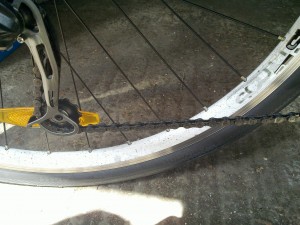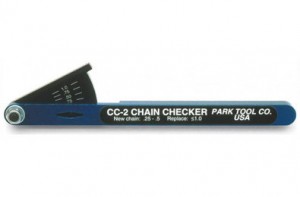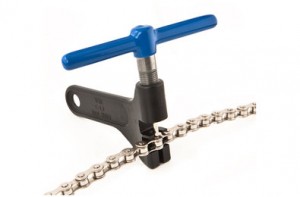A classic rookie mistake is to put too much lube onto the chain. Like I do 😉
All we need is a light coating on the top and on the bottom of the chain – above and below the rear derailleur. So get your bottle of lube out, spin the pedals backwards and apply one layer at the top. You’ll see where you’ve been (and if not, stop after about 3 full rotations of the pedals).

Next do the same on the bottom where the chain leaves the rear derailleur and is being taken up again my the front derailleur. The cassette and sprockets don’t need lube, only the chain.
Once that’s done, leave it all alone for about an hour. Over time the lube will creep into every nook and cranny of the chain and the mechanics. If you’re in a hurry, you can cycle immediately. Just keep in mind that all kinds of rattling will disappear a bit later. Too much lube isn’t bad though, just be aware that it will just get sprayed all over your frame and you’ll attract more dirt.
Chain Wear
Did you know that your chain is subject to wear and tear? Of course you did. So did I – but I had no idea on how quickly a chain can wear out and what the consequences can be. Ciaran (the guy who ran the workshop) said he’s wearing his chains out every other week – and he’s only cycling 5 miles every day.
A worn chain isn’t actually noticeable to the naked eye, but once it’s worn out it’ll start wearing out the rear cassette and the front gears. Once those are down you’ll notice your gears start slipping (i.e. won’t go in anymore, even with properly adjusted derailleurs).

How often you need to replace the chain depends on your personal riding style: when you’re hammering it down in a high gear, often standing on your pedals, you’ll put a lot of tension on your chain and it will wear out quicker. If you have a softer approach and you’re taking hills less aggressive it’ll last longer – it all depends on your riding style.
So how can you tell when a chain is wearing out? Well there’s this little gadget called a Chain Checker. It basically has two knobs that can tell over about 10cm how far your chain has drifted apart. If it’s more than 1mm it’s time for a new chain. I’ll have to get myself one of those.

If it’s time to replace the chain you can even do that yourself: all you need is a Chain Tool which lets you take your old chain off and screw the new one back on.It’s a rather simple tool that pops the pin out of a chain link and puts it back together afterwards. And all that for a tenner. Nice!
You also need a new chain that fits your bike too (obviously). You need the correct chain for your rear derailleur (if you have an 8 speed cassette you need an 8 speed chain, likewise if you have a 9 speed cassette you need a 9 speed chain and so forth – they vary in thickness you know).
I’m told they’re about £30 and come much longer than you probably need them to be. That’s a good thing! The thing to do is to count the links of your old chain and then shorten your new chain to that amount. Simply putting them next to each other won’t give you an accurate reading anymore as you can imagine.
Adjusting Your Brakes
Unless you’re using Hydraulic Disc Brakes, you’ll have cables that will go from your brake levers on the handle bars to your brakes. When you pull the brake, you stretch the cable. Over time it’ll get longer and no matter how hard you pull the lever you won’t get enough stopping power anymore. The same principle applies to your gears.